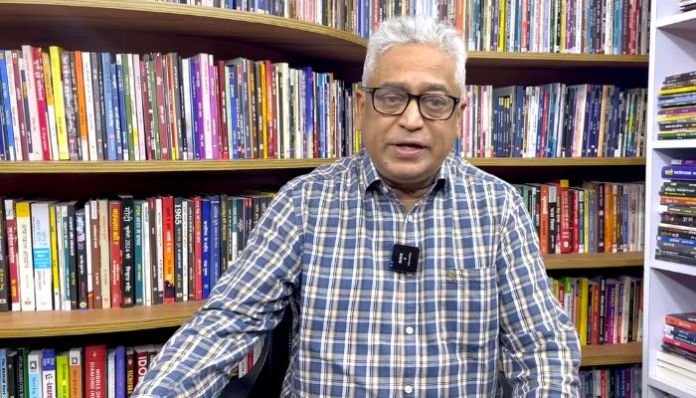On 22nd February, journalist and husband of TMC MP Sagarika Ghose, Rajdeep Sardesai, published a video on his personal channel on YouTube titled “Election Commissioner Haazir Ho”. In the video, he tried to set a narrative that the current Central Government under the NDA, led by Prime Minister Narendra Modi, is “unconstitutionally controlling” the Election Commission, which is supposed to be an autonomous body to ensure fair elections in the country.
In the almost 15-minute-long video, Sardesai made several claims where he contradicted himself and concealed crucial facts that would have completely dismantled his narrative.
The appointment of the chief election commissioner
Sardesai began his monologue by claiming that the appointment of the Chief Election Commissioner (CEC) had been manipulated by the Modi government to consolidate control over the Election Commission. He claimed that the recent appointment of Gyanesh Kumar as the new CEC was compromised and had been designed to favour the ruling party at the Centre.
Interestingly, he cited the Supreme Court’s 2023 ruling, in which the apex court had recommended a selection panel comprising the Prime Minister of India, the Leader of the Opposition, and the Chief Justice of India. He claimed that the selection panel was suggested by the court to ensure fair appointments.
However, Rajdeep expressed outrage that the Modi government later amended the process by bringing in a law that replaced the Chief Justice with a cabinet minister. This law, thus, gave the ruling party a 2:1 majority in the selection panel. It should be noted that he himself pointed out that the Supreme Court had categorically stated that the suggested selection panel would function until a law was passed in Parliament for the same. Nowhere did the court state that the CJI must be on the panel.
Furthermore, Sardesai tauntingly cited pro-government voices who pointed out that before the apex court’s ruling, the CEC was selected solely by the government or, in the case of Congress, by Sonia Gandhi, without involving the Leader of the Opposition in the process. Opposition parties were merely informed about the new CEC.
How was the CEC appointed earlier and how PM Modi made the law more inclusive
In a recent report, OpIndia explained a petition in Supreme Court where advocate Prashant Bhushan’s organisation, Association for Democratic Reforms (ADR), has challenged the law brought to elect CEC.
While ADR and Prashant Bhushan target the Central Government and PM Modi specifically, the new law brought by the Modi government actually made the process of appointment of CEC far more inclusive.
The truth is before the Modi government passed a law, the law itself had no procedure for appointing members of the Election Commission. Article 324 of the Constitution vests the “superintendence, direction and control of elections” in an Election Commission. It also says the EC shall consist of the Chief Election Commissioner and such number of other Election Commissioners, if any, as the President may fix from time to time.
This procedure would be governed by any law that the Parliament would pass. However, for 40 years, there was only the provision for a CEC and not other members like ECs. In 1989, it became a multi member body but soo, the law was rescinded in 1990. A law was enacted in 1991 to fix the conditions of service of the CEC and the ECs, and amended in 1993. Despite the law being passed, there was no provision added for the appointment of CECs and ECs.
In the absence of any law enacted by the Parliament, for 40 years, the Law Ministry would recommend a few names to the Prime Minister who in turn would recommend one name for the EC to the President of India. It had become a convention to appoint officials as ECs first and then, on the completion of the tenure of the CEC, the senior EC was elevated to CEC. It is therefore evident that before the law was passed by the Modi government, which included the Leader of the Opposition, the government of India had the sweeping power to appoint the EC who had an automatic elevation process to become the CEC. The law brought in by PM Modi ensured the participating of not just the Government of India but also the opposition.
Despite the Modi government making the law more inclusive and fair, ADR and Prashant Bhushan have been approaching the court to target the government. However, it was the Supreme Court of India that had said that the arrangement where CJI would have been involved in selection of CEC would be in effect only till a law is passed.
Allegations of proximity to the ruling party
Sardesai attempted to discredit Gyanesh Kumar’s appointment by highlighting the key posts he had previously held under Home Minister Amit Shah. He claimed that his involvement in the abrogation of Article 370, the creation of the Shri Ram Janmabhoomi Teerth Kshetra Trust, and his recent role as Secretary of Cooperatives made Gyanesh Kumar an “Amit Shah Man”, effectively suggesting that the appointment was politically motivated.
He did mention that former CECs like M.S. Gill, Navin Chawla, and others during Congress’s tenure were embroiled in controversies. However, according to him, the recent appointments raised more red flags for reasons only known to him. For the unaware, M.S. Gill became a Union Minister under the UPA, and Navin Chawla’s role during the Emergency has always been under scrutiny due to his close proximity to Sanjay Gandhi. Not to forget, the BJP had written to the then-President of India requesting Chawla’s removal, pointing out several reasons that made it clear he was a “Gandhi Family Man”.
He categorically named TN Seshan to glorify the CEC appointed by the Congress government and claimed that “no one called Seshan a ‘Congress Man’”. While no one denies the reforms Seshan introduced in the Election Commission, it must be pointed out that he contested the 1999 Lok Sabha Elections on a Congress ticket against the BJP’s LK Advani from Gandhinagar—and lost. According to Election Commission of India (ECI) data, while Advani secured 4,53,229 votes, Seshan managed to secure only 2,64,285 votes. Seshan also attempted to contest the 1997 Presidential elections against KR Narayanan but lost.
Questioning the Election Commission’s neutrality
Moving further in his monologue, Sardesai claimed that the Election Commission under the Modi government has “lost its neutrality.” He alleged that there have been instances where the EC’s decisions favoured the ruling party, specifically regarding election schedules and Model Code of Conduct violations.
He claimed that Maharashtra, which has 48 Lok Sabha seats, was subjected to a five-phase election, whereas Tamil Nadu, with 39 seats, had a single-phase poll. Odisha, a smaller state with just 21 seats, was given a four-phase election. He framed this as an attempt to manipulate voting patterns but failed to provide any evidence of how these decisions benefited the BJP. Notably, the number of phases in which elections are held in any state depends on logistical, security, and administrative factors, and such delays are not unprecedented.
He further claimed that the EC delayed the Assembly Elections in Maharashtra, which benefited the BJP as the government rolled out welfare schemes like the Ladli Behna initiative, which, according to him, was a game changer. However, he completely ignored the fact that the Lok Sabha Elections in 1991 were postponed for a month after the assassination of Rajiv Gandhi.
Congress was virtually wiped out in the first phase of the Lok Sabha elections, held a day before Rajiv Gandhi was killed in a bomb blast. However, due to the delay announced after his assassination, Congress gained sympathy votes and swept the second phase. It was the then-Election Commissioner T.N. Seshan who delayed the elections for a month, giving Congress the opportunity to take advantage of the tragedy.
Voter roll manipulation claims
Sardesai then claimed that the voter list in Maharashtra had been manipulated, citing an increase of 40 lakh new voters between the Lok Sabha Elections in May and the Assembly Elections in November. He argued that this was an unusual spike, far greater than the previous five-year net addition of 32 lakh voters. By raising doubts over the legitimacy of this increase, he insinuated that the EC had allowed voter fraud to benefit the ruling party.
However, here is the catch. If we look at the historic data on the number of voters added between the past five Lok Sabha and Vidhan Sabha elections—without considering the results—the percentage increase in the number of voters between Lok Sabha Elections and Assembly Elections has remained almost the same four times, at around 4%, which can be attributed from the table below. As it is evident, while 4.26% voters increased in 2024, 1.31% increased in 2019, 3.48% 2014, 4.13% in 2009 and 4.69% (more than 2024) in 2004.
Rajdeep Sardesai’s monologue was yet another example of selective outrage and fact-twisting. It was clearly aimed at discrediting the Modi government while conveniently ignoring similar or worse precedents set by past regimes. His attempts to portray the appointment of the Chief Election Commissioner as a “midnight coup” fell apart when his own statements confirmed that the selection process followed legal procedures. His criticism of Gyanesh Kumar’s appointment as politically motivated was undermined by his silence on Congress-era appointments that were blatantly partisan.





Average Rating